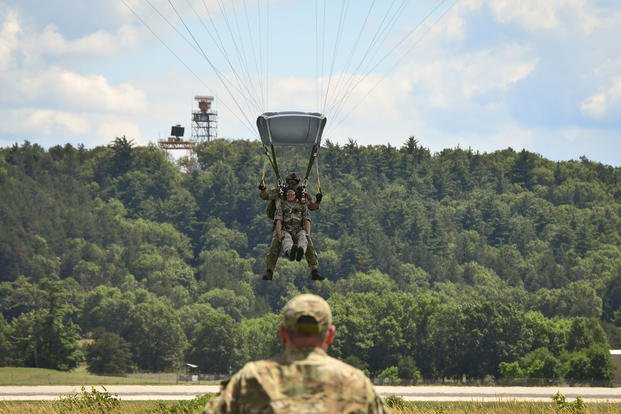Mission
Air Force Special Operations Command's pararescuemen, also known as PJs, are the only Defense Department specialty specifically trained and equipped to conduct conventional or unconventional rescue operations. These battlefield airmen are the ideal force for personnel recovery and combat search and rescue.
A PJ's primary function is as a personnel recovery specialist, with emergency medical capabilities in humanitarian and combat environments. PJs deploy in any available manner, including air-land-sea tactics and into restricted environments to authenticate, extract, treat, stabilize and evacuate injured personnel. PJs participate in search and rescue, combat search and rescue, recovery support for NASA and conduct other operations as appropriate.
Pararescuemen are among the most highly trained emergency trauma specialists in the U.S. military. They must maintain an emergency medical technician-paramedic qualification throughout their careers. With this medical and rescue expertise, along with their deployment capabilities, PJs are able to perform life-saving missions in the world's most remote areas.
Their motto, "That Others May Live," reaffirms the PJ's commitment to saving lives and self-sacrifice. Without PJs, thousands of service members and civilians would have been lost unnecessarily in past conflicts and natural disasters.
Training
Pararescuemen endure some of the toughest training offered in the U.S. military. Their training, as well as their unique mission, earns them the right to wear the maroon beret. They complete the same technical training as EMT-paramedics, plus the following physical and specialized training:
Indoctrination course, Joint Base San Antonio-Lackland, Texas
This 10-week indoctrination course trains future PJs through extensive physical conditioning. Training accomplished at this course includes physiological training, obstacle course, rucksack marches, dive physics, dive tables, metric manipulations, medical terminology, cardiopulmonary resuscitation, weapons qualifications, PJ history and leadership reaction course.
U.S. Army Airborne School, Fort Benning, Ga.
Trainees learn the basic parachuting skills required to infiltrate an objective area by static-line airdrop in a three-week course.
USAF Combat Diver Course, Panama City, Fla.
Trainees become combat divers, learning to use SCUBA and closed-circuit diving equipment to infiltrate denied areas covertly, conduct sub-surface searches and basic recovery operations. The six-week course provides training to depths of 130 feet, stressing development of maximum underwater mobility under various operating conditions.
U.S. Navy Underwater Egress Training, Pensacola Naval Air Station, Fla.
This course teaches how to escape from an aircraft that has ditched into the water safely. The one-day instruction includes principles, procedures and techniques necessary to get out of a sinking aircraft.
U.S. Air Force Basic Survival School, Fairchild AFB, Wash.
This 2½-week course teaches basic survival techniques for remote areas. Instruction includes principles, procedures, equipment and techniques, which enable individuals to survive, regardless of climatic conditions or unfriendly environments and return home.
U.S. Army Military Free Fall Parachutist School, Fort Bragg, N.C., and Yuma Proving Grounds, Ariz.
This course instructs trainees in free-fall parachuting procedures. The five-week course provides wind-tunnel training, in-air instruction focusing on student stability, aerial maneuvers, air sense and parachute-opening procedures.
Paramedic Course, Kirtland AFB, N.M.
This 22-week course teaches how to manage trauma patients prior to evacuation and provide emergency medical treatment. Upon graduation, an EMT-paramedic certification is awarded through the National Registry.
Pararescue Recovery Specialist Course, Kirtland AFB, N.M.
This course qualifies airmen as pararescue recovery specialists for assignment to any pararescue unit worldwide. The 24-week training includes field medical care and extrication basics, field tactics, mountaineering, combat tactics, advanced parachuting and helicopter insertion/extraction.
More Air Force Special Operations articles:
Air Force Pararescue Jumper Fitness
Air Force Special Tactics Fitness Training
Helicopter Rescue Swimmer Training
All Air Force Special Operations Articles
Learn more about available Special Operations opportunities.
Stew Smith is a former Navy SEAL and fitness author certified as a Strength and Conditioning Specialist (CSCS) with the National Strength and Conditioning Association. Visit his Fitness eBook store if you’re looking to start a workout program to create a healthy lifestyle. Send your fitness questions to stew@stewsmith.com.
Want to Learn More About Military Life?
Whether you're thinking of joining the military, looking for fitness and basic training tips, or keeping up with military life and benefits, Military.com has you covered. Subscribe to Military.com to have military news, updates and resources delivered directly to your inbox.





















